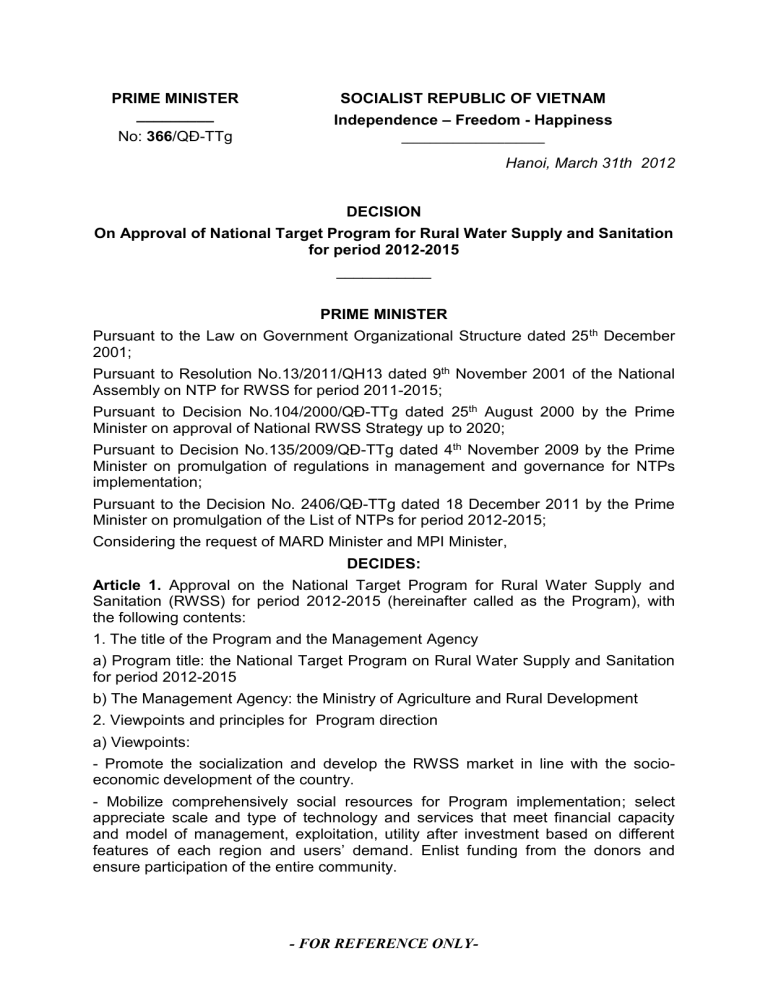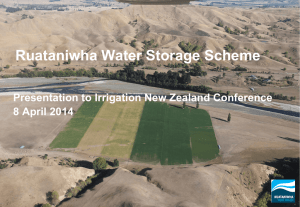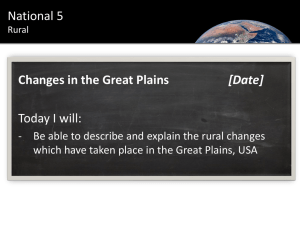DECISION No: 366/QĐ-TTg on Approval of National Target Program

PRIME MINISTER
_________
No: 366
/QĐ-TTg
SOCIALIST REPUBLIC OF VIETNAM
Independence
– Freedom - Happiness
_________________________
Hanoi, March 31th 2012
DECISION
On Approval of National Target Program for Rural Water Supply and Sanitation for period 2012-2015
___________
PRIME MINISTER
Pursuant to the Law on Government Organizational Structure dated 25 th December
2001;
Pursuant to Resolution No.13/2011/QH13 dated 9 th November 2001 of the National
Assembly on NTP for RWSS for period 2011-2015;
Pursuant to Decision No.
104/2000/QĐ-TTg dated 25 th August 2000 by the Prime
Minister on approval of National RWSS Strategy up to 2020;
Pursuant to Decision No.
135/2009/QĐ-TTg dated 4 th November 2009 by the Prime
Minister on promulgation of regulations in management and governance for NTPs implementation;
Pursuant to the Decision No.
2406/QĐ-TTg dated 18 December 2011 by the Prime
Minister on promulgation of the List of NTPs for period 2012-2015;
Considering the request of MARD Minister and MPI Minister,
DECIDES:
Article 1.
Approval on the National Target Program for Rural Water Supply and
Sanitation (RWSS) for period 2012-2015 (hereinafter called as the Program), with the following contents:
1. The title of the Program and the Management Agency a) Program title: the National Target Program on Rural Water Supply and Sanitation for period 2012-2015 b) The Management Agency: the Ministry of Agriculture and Rural Development
2. Viewpoints and principles for Program direction a) Viewpoints:
- Promote the socialization and develop the RWSS market in line with the socioeconomic development of the country.
- Mobilize comprehensively social resources for Program implementation; select appreciate scale and type of technology and services that meet financial capacity and model of management, exploitation, utility after investment based on different features of each region and users’ demand. Enlist funding from the donors and ensure participation of the entire community.
- FOR REFERENCE ONLY-
- Give priority to disadvantaged areas and the poor; especially disadvantaged areas where are prone to drought, pollution; mountainous and coastal areas, islands. b) Principles
- The program will be implemented in hand with the socio-economic development strategy, NTP for RWSS by 2020 and in contribution to implement the National
Target Program new rural areas development by 2020; ensure the sustainable operation and proved effectiveness of upgraded or newly built RWSS facilities in the situation of climate changes and on the way to ensure supply of qualified water.
- Develop suitable technologies in different areas; develop modern technologies as well as low-cost technologies for household facilities in disadvantaged areas.
- Focus on sanitation targets, particularly household latrines with priority to low-cost models and preferential credit to improve the access of the poor.
- Improve the information
– education – communications activities (IEC), shift from
IEC for awareness improvement to IEC for behavior changes.
3. Objectives and missions a) Overall objective:
To implement step by step the National Strategy on water supply and rural sanitation by 2020, improve the situation of water supply and sanitation, increase the awareness of people, change behavior and minimize the environment pollution, in contribution to improve health and living standards of rural people. b) Specific objectives:
By the end of 2015, it is expected to reach the following targets:
- Water supply: 85% of rural population have access to hygienic water, 45% of which have access to clean water according to Standard QCVN 02-BYT of MoH with provision of at least 60 litres/person/day.
- Environment sanitation: 65% of rural households have hygienic latrines; 45% households have hygienic livestock pens; 100% kindergartens, schools, clinics in rural areas have hygienic latrines.
4. Beneficiaries and scope of Program implementation
Rural households throughout the country, with immediate priority to the poor, people in remote and isolated areas, ethnic minority, border and coastal areas, islands, polluted and water disadvantaged areas.
5. Timing for Program implementation
The Program is scheduled to be implemented from 2012 to the end of 2015.
6. Total budget, funding structure and supporting mechanism for Program implementation, list of projects under the Program a) Total budget: VND 27,600 billion b) Funding structure:
- Central budget: VND 4,100 billion, accounting for 14.9%
- Local budget: VND 3,100 billion, accounting for 11.2%
- International grants: VND 8,200 billion, accounting for 29.7%
- Credit component: VND 9,100 billion, accounting for 33.0%
- FOR REFERENCE ONLY-
- Funds of individuals and private sector: VND 3,100 billion, accounting for 11.2% c) The list of projects:
- Project 1: Water supply and rural environment
+ Objectives: 85% of rural population have access to hygienic water, 45% of which have access to clean water according to the Standard QCVN 02-BYT of MoH with provision of at least 60 litres/person/day; 100% kindergartens, shools, clinics in rural areas have hygienic latrines under good operation and management; 45% households have hygienic livestock pens.
+ Allocated budget: VND 19,725 billion.
+ Sub-projects:
Sub-project 1: Water supply, including: build water supply facilities in rural areas, border posts in residential concentrations of border areas and jails, with priority to especially water disadvantaged areas: mountainous, salt-infected, arsenic-infected, dioxin-infected and polluted areas.
Sub-project 2: Build water supply facilities and hygienic latrines at kindergartens and schools.
Sub-project 3: Build hygienic livestock pens.
+ Implementation organization:
Project holder: Ministry of Agriculture and Rural Development (MARD).
Managing and implementing agency: MARD is responsible to implement subproject 1 and 3; Ministry of Education and Training (MOET) is responsible to implement subproject 2; Municipal/provincial People’s Committees are responsible to implement projects under the Program in the area.
Coordinating agencies: Ministries of Health, Construction, Natural Resources and
Environment, Science and Technology, National Defense, Committee of Ethnic
Minorities, Vietnam Academy of Science and Technology,
Vietnam Farmers’
Assoc iation, Vietnam Women’s Union, Youth’s Union.
- Project 2: Rural sanitation
+ Objective: 65% of rural households have hygienic latrines; 100% clinics have enough clean water and hygienic latrines under good operation and management
+ Allocated budget: VND 5,961 billion
+ Sub-projects:
Sub-project 1: Build hygienic household latrines.
Sub-project 2: Build clean water supply facilities and hygienic latrines at clinics.
+ Implementation organization:
Project holder: Ministry of Health (MoH)
Managing and implementing agency: MoH is responsible to direct Program implementation;
Municipal/provincial People’s Committees are responsible to implement projects under the Program in the area.
Coordinating agencies: Ministries of Agriculture and Rural Development,
Construction, Natural Resources and Environment, Science and Technology,
National Defense, Committee of Ethnic Minorities, Vietnam Academy of Science
- FOR REFERENCE ONLY-
and Technology, Vietnam Farmers’ Association, Vietnam Women’s Union,
Youth’s Union.
- Project 3: Strengthen capacity in communications, monitoring and evaluation of
Program implementation.
+ Activities: Training for capacity strengthening of MoH system; informationeducation-communications, awareness improvement, behavior changes at all levels and at community; monitoring and evaluation of Program implementation; control of water quality; review and update of the plan; technology development and transfer; operation and maintenance of RWSS facilities.
+ Allocated budget: VND 1.914 billion
+ Implementation organization:
Project holder: Ministry of Agriculture and Rural Development.
Managing and implementing agencies: MARD, MoH and MOET is responsible to implement sub-projects accordingly;
Municipal/provincial People’s Committees are responsible to implement projects under the Program in the area
Coordinating agencies: Ministries of Information and Communications, Natural
Resources and Environment, Science and Technology, Vietnam Academy of
Science and Technology, Vietnam Farmers’ Association, Vietnam Women’s
Union, Youth’s Union. d) Mechanism for resources mobilization
- Diversify resources:
+ Integrate with other resources of other national target programs, sponsored programs and projects in the area, including:
Supporting resources directly from NTP for RWSS for the period 2012 - 2015.
Integrated resources from other sponsored programs and projects which also pursue the same goals on RWSS in the area.
+ Local resources (at provincial, district and commune levels) will be maximized to implement the Program, Municipal/Provincial People’s Committees intend at least
10% of total local budget to implement the Program in the area.
+ Investment resources from enterprises and individuals for RWSS facilities that they can easily take back their investment money directly; enterprises who are beneficiaries of the development investment credit from the Government under
Decision No. 7
1/2010/QĐ-TTg dated 9 November 2010 of the Prime Minister on regulations for investment of pilot cooperation model between private sector and state sector.
+ Pe ople’s contribution in specific projects. .
+ Resource from international donors.
+ Effective and efficient implementation of preferential credit: Preferential credit under the Decision 62/2004/QĐ-TTg dated 16 April 2004 of the Prime Minister;
Commercial credit under the Decree No. 41/2010/NĐ-CP dated 12 April 2010 of the
Prime Minister on credit policies for agriculture and rural development.
+ Other legal financial resources.
- Supporting mechanism:
- FOR REFERENCE ONLY-
The supporting mechanism will works on the principal of sufficient resource for investment and operation expenses for sustainable operation of RWSS facilities.
Funding volume and balance will be determined to be suitable to different regions and specific RWSS facilities in the way to ensure access of the poor in remote and isolated areas to RWSS facilities, details as follows:
+ Development investment resources:
Public water supplies:
Central budget: at most 90% required amount for especially disadvantaged communes in mountainous, coastal and border areas, islands, ethnic minorities under the regulations of the Prime Minister; 60% required amount for communes in delta and 75% for communes in rural areas.
Local budget and other legal resources (preferential credit, investment of private sector, people’s contribution): To ensure the rest amount. If the localities can balance their budget to intend certain budget for the Program, it should maximize the resource mobilization from the community and private sector.
Household water supplies: the State budget will finance at most 70% of total cost for the poor and policy beneficiaries and 35% for near-poor households; other rural households can apply for preferential loans under the regulations.
Water supplies at schools and clinics: the State budget will finance at most 90% of the total cost. For those who do not have income, provincial People’s
Committee will decide the supporting amount from the state budget.
+ State budget:
The state budget will finance fully the following activities: Training for capacity strengthening, information-education-communication, investigation, monitoring and evaluation, water quality control, planning, technology transferring, assistance to local network etc,.
For building hygienic latrines and livestock pens (with biogas system): state budget will finance 70% of total cost for the poor and policy beneficiaries and
35% for the near-poor households, other rural households will be beneficiaries of preferential lending.
+ Specific criteria for budget allocation:
Ministry of Agriculture and Rural Development will take lead to develop and issue the mechanism and criteria for budget allocation for each components and each projects with consultancy (supplement and amendment) of Ministry of Finance, Ministry of
Planning and Investment and Ministry of Health.
- Management mechanism for investment:
+ Investors of RWSS facilities will directly manage and operate RWSS facilities. In case investors do no have enough capacity to do that, provincial People’s
Committee will consider and select other eligible investors.
+ During preparation process, it is necessary to have a report of people’s opinions on the investment project or a economic and technical report, commitment to utilize and pay for water supply of local households.
+ Select a contractor: Select a contractor under the prevailing regulations, encourage the eligible beneficiary community to build RWSS works with simple technical requirements.
- FOR REFERENCE ONLY-
+ The members of the community monitoring board are representatives of the
People’s Council, National fatherland front at commune, social organizations and beneficiary community, who are selected by people and take responsibility to supervise and monitor the RWSS facilities under the prevailing regulations on community investment.
7. Key solutions a) Special mechanism and policies need to be issued
MARD will take lead and collaborate with line ministries and agencies to review, amend and supplement the regulations on financial and technical management, preferential policies to encourage investment in constructions and management of clean water supply facilities, technical standards, guideline in management, exploitation and maintenance of RWSS facilities to facilitate Program implementation; review and design the collaboration mechanism among line
Ministries, agencies and provinces for effective and efficient implementation. b) Information
– education - communication:
Information-education-communication will be performed under the following methods:
- Direct communication at hamlets for grassroots propagandists and people.
- Newspaper, radio and television channels will be prioritized at national and provincial level.
- Social marketing to increase the demand to build and utilize the latrines and have hygienic practices; use clean water and build hygienic latrine.
- Devolve higher responsibilities to localities, agencies and mass organizations at all levels in Program implementation. c) Expanding international cooperation:
Enhance international cooperation with an aim to experiences exchange, inforamtion sharing, technology transfer and attraction of ODA grant and other favourable credit funds.
Establish transparent and flexible collaboration mechanism between Government agencies and donors to create a transparent, favorable and efficient environment for the Program; Generate partnership activities between Vietnam and RWSS international donors.
Utilize funds from the donors effectively and efficiently and effectuate the commitments in the agreement. d) Post-investment management:
Focus on post-investment effectiveness with priority to management model and mechanism of public facilities; shift from the model of self-service operation to service operation. Accordingly based upon the demand of customers, the management and operation organization will make appreciate changes to service delivery approach.
After RWSS facilities are built, it is necessary to have the regulations on operation procedures with timing, process, maintenance, repair and replaced equipments.
The management staff of RWSS facilities must be trained, have good professional skills and qualified to operate facilities under the prevailing regulations.
- FOR REFERENCE ONLY-
Service price for qualified water has to be calculated correctly, adequately, covering all reasonable expenditures in production and delivery, including tax and profits. The price will be submitted to the provincial People’s Committee for approval. In case the suggested price is lower than the total cost, local competent authorities will extract from the local budget to give subsidies to water supply agencies. đ) Human resource, science and technology:
- Human resource:
Focus on training and HR development, with priority to capacity strengthening for state management staff at all levels, services and business organizations, especially grassroots propagandists.
Select appreciate training courses for each target groups, have prompt guides and instructions on legal documents, planning design, science and technology, project development and management, communication, management, exploitation and operation of RWSS facilities etc.,
Training methods: Training, study visit, workshop etc,. under the learner-centered method.
- Science and technology:
+ Water supply: Select suitable and effective technical solutions, particularly in specially disadvantaged areas (where are prone to drought, flood, pollution, mountainous areas and islands etc,.). Diversify water supply technology in exploitation, utilization and improvement of water quality in accordance with naturaleconomic-social conditions of each regions to ensure sustainable development.
Prioritize sustainable water resources in specially disadvantaged areas; public water supply facilities in polluted areas; upgrade and expand the current water supply facilities and ensure water quality.
+ Sanitation: Select suitable types of latrines based upon the natural features and local habits in different regions.
+ Technology for animal waste treatment: Focus on animal waste treatment for household husbandry under the traditional methods with priority to Biogas system. e) Community participation
Enhance the participation of community to create convenient and equal opportunities for all people to get benefit from and actively participate in Program; The Program has to be implemented in line with the regulations on grassroots democracy, encourage to hold the meetings at villages and hamlets to discuss the local priorities and make decision on relevant RWSS issues. .
8. Implementation a) At central level:
- MARD Minister is to issue the decision on establishment of Steering Committee
(SC) of NTP for RWSS 2012-2015; Steering Committee management board includes: MARD Minister
– the chairperson, MARD Deputy Minister – standing deputy chairperson; MoH Deputy Minister – vice chairperson and SC members are the representatives of Ministries of Planning and Investment, Finance, Construction,
Education and Training, National Defense, Natural Resources and Environment,
Science and Technology, Information and Communication , Committee of Ethnic
Minorities, Vietnam Farmers’ Association, Vietnam Women’s Union, Youth’s Union.
- FOR REFERENCE ONLY-
- The SC chairperson will make decision on SC operation regulations.
- The Standing Office located in MARD will assist the SC. Considering different component projects under the Program, the implementation agencies can establish the Project Management Unit under the decision of the Head of implementation agencies. b) At local level
The chairperson of provincial People’s Committee will issue decision to establish the local SC to implement NTP for RWSS 2012-2015 in the area. The management board of local SC will include: a chairperson who is the representative of the management board of provincial People’s Committee, a standing vice chairperson who is the representative of management board of provincial Department of
Agriculture and Rural Development and a vice chairperson who is the representatives of the management board of provincial Department of Health. The members of local SC will be the representatives of the management boards of relevant provincial agencies and mass organizations.
Article 2. This Decision comes into effect since the signing date.
Article 3. Ministers, Leaders of ministerial equivalents, Leaders of Government agencies, sociopolitical organizations and Chairpersons of People’s Committees of provinces and centrally-run cities are responsible to effectuate this Decision.
./.
PRIME MINISTER
(Signed)
Nguyen Tan Dung
- FOR REFERENCE ONLY-







